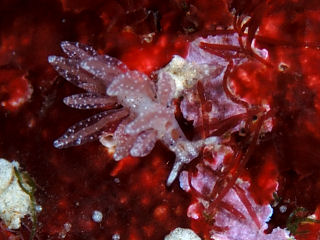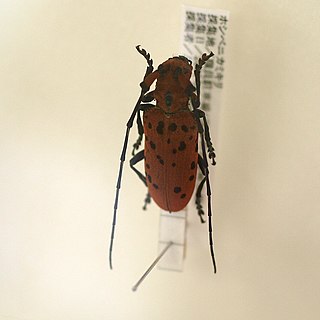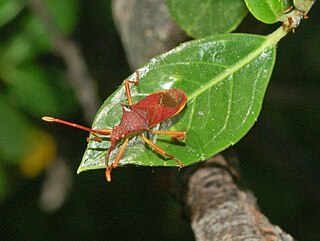Related Research Articles

Stiliger is a genus of small and minute sacoglossan or sap-sucking sea slugs. They are marine gastropod mollusks in the family Limapontiidae.

The black-striped squirrel is a species of rodent in the family Sciuridae. It is found throughout Java, Sumatra, southern Thailand, the Malay Peninsula, and numerous small islands. This taxon consists of four subspecies: C. n. nigrovittatus, C. n. bilimitatus, C. n. bocki, and C. n. klossi. It is listed as "least concern" by the IUCN.

Tabanus nigrovittatus, also known as the greenhead horse fly, salt marsh greenhead, or simply the greenhead fly, greenhead or greenfly, is a species of horse-fly commonly found around the coastal marshes and wetlands of the Eastern United States. They are smaller than most horsefly species, instead being close in size to a common housefly. The biting females are a considerable pest to both humans and animals while they seek a source of blood protein to produce additional eggs: greenhead larvae develop in the mud of salt marshes, and adult flies mate and lay their first group of eggs in the marsh, but to lay more eggs a female fly needs to drink an animal's blood, and so female greenheads which have laid eggs fly inland to look for prey in the area bordering the marsh; they can stay on land looking for animals to bite for up to four weeks. Their bites itch, like those of mosquitoes, but are more painful, since greenheads feed by cutting a wound in the skin with scissor-like mouth parts and sucking the blood released through it. Females live for three to four weeks and may lay about 100 to 200 eggs per blood meal. The eggs are laid on the grass in a salt marsh; the larvae live in the intertidal mud of the salt marsh for one or two years, preying on other invertebrates, before pupating in early spring. The adult flies emerge in late spring and are most common from late June to August.
Microchironomus is a genus of European non-biting midges in the subfamily Chironominae of the bloodworm family Chironomidae.
Greenfly may refer to:
Pseudocrossocheilus is a genus of cyprinid fish endemic to China. There are currently five recognized species in this genus.
Spilarctia nigrovittatus is a moth in the family Erebidae. It was described by Shōnen Matsumura in 1911. It is found in Taiwan.
Aegomorphus nigrovittatus is a species of beetle in the family Cerambycidae. It was described by Zajciw in 1969.

Lamiini is a tribe of longhorn beetles of the subfamily Lamiinae.

Eupromus is a genus of longhorn beetles of the subfamily Lamiinae, containing the following species:
Pseudobrimus is a genus of longhorn beetles of the subfamily Lamiinae, containing the following species:

Gonocerus is a genus of squash bugs belonging to the family Coreidae.

Eupromus laosensis is a species of beetle in the family Cerambycidae. It was described by Stephan von Breuning in 1968. It is known from Laos.

Eupromus ruber is a species of beetle in the family Cerambycidae. It was described by Dalman in 1817. It is known from Japan, China, and Taiwan. It feeds on Cinnamomum camphora and Cunninghamia lanceolata.
Monochamus nigrovittatus is a species of beetle in the family Cerambycidae. It was described by Stephan von Breuning in 1938. It is known from Sierra Leone and the Ivory Coast.
Pseudobrimus nigrovittatus is a species of beetle in the family Cerambycidae. It was described by Stephan von Breuning in 1959.
Pseudocrossocheilus nigrovittatus is a species of cyprinid fish endemic to China. They live in on the bottom of fast flowing rivers and reach a maximum length of 9.7 cm.
Obelistes is a genus of leaf beetles in the subfamily Eumolpinae. It is known from Africa.
Neolissochilus nigrovittatus is a species of cyprinid in the genus Neolissochilus. It inhabits Myanmar and Thailand and has a maximum length of 13.0 centimetres (5.1 in).
Pseudochromis nigrovittatus, the blackstripe dottyback, is a species of ray-finned fish in the family Pseudochromidae. It is found in the western Indian Ocean.
References
- ↑ BioLib.cz - Eupromus nigrovittatus. Retrieved on 8 September 2014.